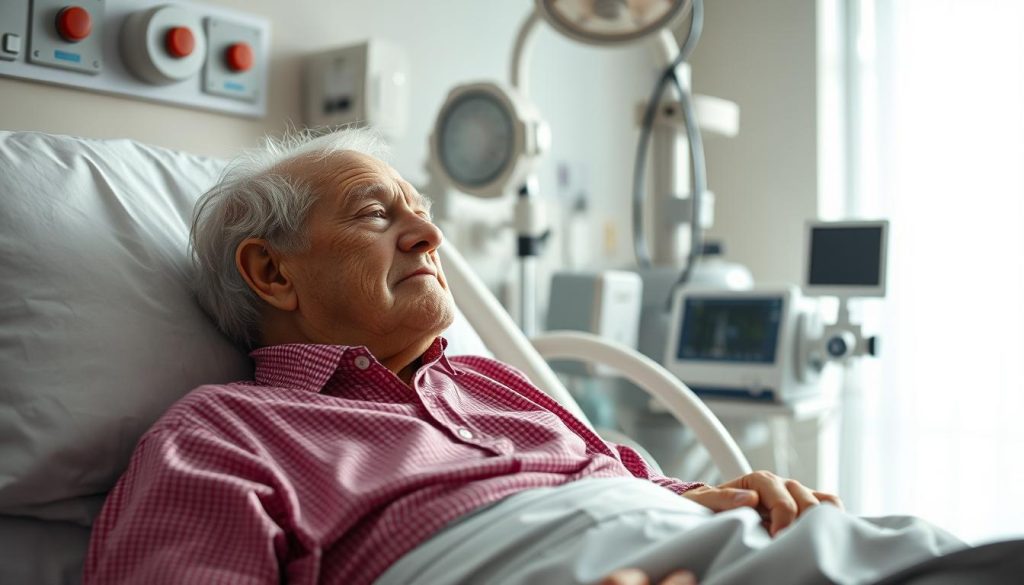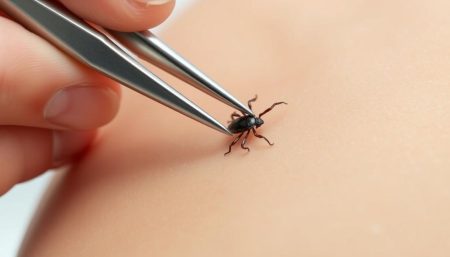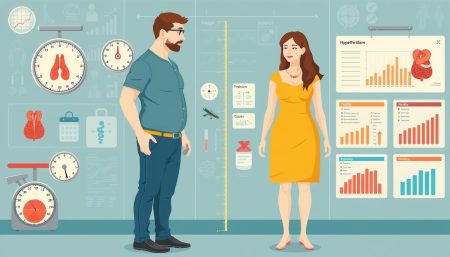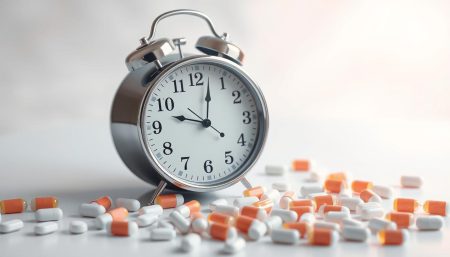Broken Femur Surgery with Rod Elderly Femur fractures in older adults are a big challenge for doctors. This guide looks at broken femur surgery with a rod for seniors. It covers the causes, types of fractures, and surgery options for older patients.
As we get older, our bones get weaker, making fractures more likely. This guide offers insights for patients, caregivers, and doctors on treating broken femurs with a rod in seniors. It focuses on the care and rehab needed for older adults to recover well.
This guide covers everything from before surgery to after. It helps us understand the special care needed for femur fractures in seniors. Knowing this can help us better prepare and manage these challenges.
Understanding Femur Fractures in Elderly Patients
Femur fractures in elderly patients are serious injuries. They often need special hip fracture repair. These breaks can greatly affect seniors’ mobility and quality of life.
Broken Femur Surgery with Rod Elderly: Common Causes of Femoral Fractures in Seniors
Falls are the main cause of femur fractures in older adults. Other causes include accidents and health conditions that weaken bones. Seniors with poor balance or vision problems are at higher risk of falls and fractures.
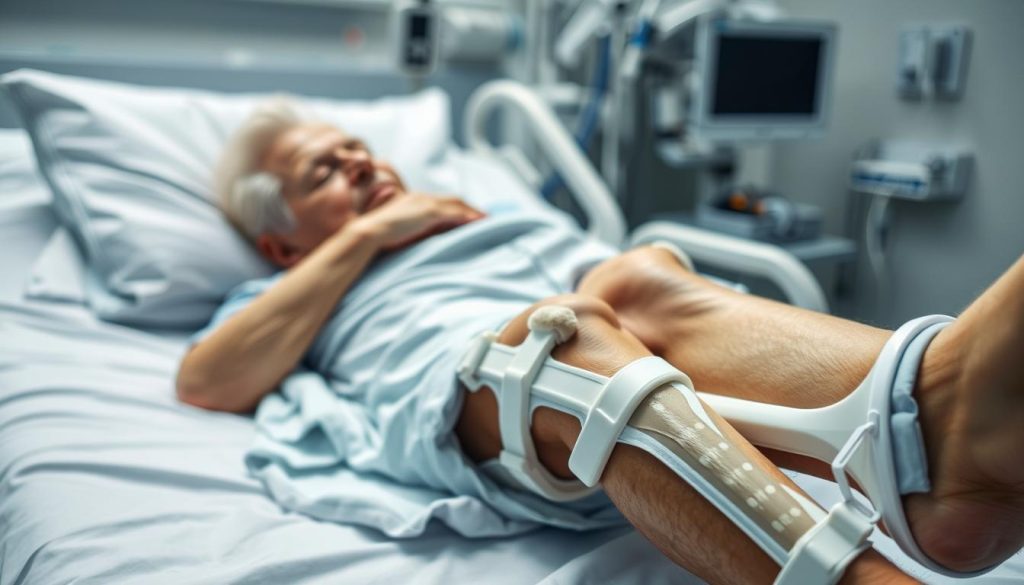
Types of Femur Breaks in Older Adults
Femur fractures in seniors usually fall into three types:
- Intracapsular fractures: Occur at the hip joint
- Intertrochanteric fractures: Happen between the hip joint and thighbone
- Subtrochanteric fractures: Located below the hip joint
Impact of Osteoporosis on Femur Fractures
Osteoporosis is a big factor in femur fractures among the elderly. It weakens bones, making them more likely to break. It’s key to manage osteoporotic fractures well to prevent and treat femur fractures in seniors with this condition.
| Factor | Impact on Femur Fractures |
|---|---|
| Osteoporosis | Increases fracture risk by 2-4 times |
| Age | Risk doubles every 5-7 years after age 50 |
| Gender | Women at higher risk due to bone density loss |
Knowing these factors helps doctors create better treatment plans and prevention strategies for elderly patients at risk of femur fractures.
Broken Femur Surgery with Rod Elderly: Overview and Procedure
Intramedullary nailing is a top choice for fixing femoral shaft fractures in older adults. This method involves placing a metal rod inside the femur’s hollow part. It helps stabilize the broken bone.
The surgery starts with a small cut near the hip. Then, the rod is carefully placed through the bone’s length. Screws hold it in place at both ends. This method causes less damage and blood loss, which is good for older patients with weaker health.
Benefits of intramedullary nailing for seniors include:
- Less surgical trauma
- Quicker recovery times
- Better weight-bearing abilities
- Lower chance of infection
Doctors look at several things before choosing this method. They consider the fracture type, the patient’s health, and the future outlook. For example, a simple fracture might be best for intramedullary nailing. But a complex fracture might need more than one method.
After surgery, patients start physical therapy soon. Moving early helps avoid problems like blood clots and muscle loss. With the right care and therapy, many older patients can move well and live independently again.
Pre-operative Assessment and Medical Clearance
Before geriatric orthopedic surgery, a detailed pre-operative check is needed. This ensures the safety and best results for elderly patients with femur fractures.
Required Medical Tests
Many medical tests are key for managing osteoporotic fractures. They check the patient’s health and if they’re ready for surgery:
- Complete blood count
- Electrocardiogram (ECG)
- Chest X-ray
- Urinalysis
- Coagulation profile
Medication Adjustments
Elderly patients often take many medications. These can affect surgery or recovery. The medical team reviews and changes medications as needed:
| Medication Type | Adjustment | Timing |
|---|---|---|
| Blood thinners | Temporary discontinuation | 5-7 days before surgery |
| Diabetes medications | Dose modification | Day of surgery |
| Pain medications | Potential increase | Pre and post-surgery |
Risk Evaluation for Elderly Patients
Assessing risks is critical in geriatric orthopedic surgery. Factors include:
- Existing medical conditions
- Cognitive function
- Nutritional status
- Physical frailty
This evaluation helps create a personalized surgical plan. It ensures the best care for each patient’s needs in osteoporotic fracture management.
Intramedullary Nailing Technique for Femoral Fractures
Intramedullary nailing is a key treatment for femoral fractures in older adults. It involves putting a metal rod into the femur’s center to hold the bone together.
Modern Rod Insertion Methods
Today, surgeons use new ways to fix femur fractures with less harm. They make small cuts and use special tools to place the rod. This method helps patients heal faster and feel less pain after surgery.
Surgical Approach Options
There are two main ways to do intramedullary nailing:
- Antegrade: Rod insertion from the hip down
- Retrograde: Rod insertion from the knee up
The choice depends on where the fracture is and the patient’s body. Antegrade nailing is often used for fractures in the middle of the femur. Retrograde nailing is better for fractures closer to the knee.
Duration and Anesthesia Considerations
Intramedullary nailing usually takes 1-2 hours. There are different anesthesia options:
| Anesthesia Type | Benefits | Considerations |
|---|---|---|
| General | Complete unconsciousness | Longer recovery time |
| Spinal | Faster recovery | Limited duration |
| Regional | Localized pain control | May require sedation |
The anesthesiologist picks the best option based on the patient’s health and the surgery. This careful choice helps ensure the best results for older patients with femur repairs.
Benefits of Rod Fixation in Geriatric Patients
Rod fixation is now a top choice for treating femur fractures in older adults. It brings many benefits, making it ideal for geriatric orthopedic surgery, like broken femur surgery with a rod for the elderly.
One big plus is early mobilization. Elderly patients can start moving around sooner after surgery. This cuts down on the risks of staying in bed too long. It helps keep muscles strong and joints flexible.
Rod fixation also gives better stability to osteoporotic bones. The rod spreads out the force along the femur, helping it heal better and reducing the chance of implant failure. This is key for elderly patients with weak bones.
Surgical advantages include:
- Shorter operation time
- Reduced blood loss
- Smaller incisions
- Lower risk of infection
Long-term results for elderly patients with rod fixation are mostly good. This method lowers the chances of malunion and nonunion compared to other methods. It leads to better recovery and a higher quality of life for geriatric patients.
| Benefit | Impact on Elderly Patients |
|---|---|
| Early Mobilization | Reduces risk of bed rest complications |
| Improved Stability | Enhances healing in osteoporotic bones |
| Shorter Surgery | Decreases anesthesia-related risks |
| Better Long-term Outcomes | Improves overall quality of life |
Minimally Invasive Approaches for Elderly Femur Repair
New surgical methods have changed how we fix femurs in older adults. These new ways are less invasive and better for seniors with complex health issues.
Advanced Surgical Technologies
Today’s hip fracture repairs use the latest tech to be more precise and cause less harm. Computer systems help surgeons place implants accurately. Fluoroscopy lets them see in real-time, making adjustments as needed.
Recovery Time Comparison
These new methods mean less time in bed for recovery. This is a big plus for seniors, as it lowers the risk of problems from too much bed rest.
| Aspect | Traditional Surgery | Minimally Invasive |
|---|---|---|
| Incision Size | 6-12 inches | 2-4 inches |
| Hospital Stay | 5-7 days | 2-4 days |
| Walking Assistance | 4-6 weeks | 2-3 weeks |
Surgical Precision Benefits
These new methods are more precise, which brings many benefits. Patients feel less pain, have a lower chance of infection, and get back to their lives faster. This is great for seniors, who often have less energy to deal with surgery.
Using these advanced techniques, doctors can help seniors recover faster and get back to their normal lives sooner after a femur fracture.
Post-operative Care and Hospital Stay
After broken femur surgery, elderly patients need careful care. They usually stay in the hospital for 3-5 days. This depends on their health and how well they recover.
Keeping pain under control is very important. Nurses give medicines as needed, using both pills and shots. They also watch the wound closely for any signs of infection.
Moving around early is important for healing. Physical therapists start with simple exercises within a day of surgery. They slowly add more as the patient gets stronger. This helps avoid problems like blood clots and pneumonia.
| Post-op Day | Activities | Goals |
|---|---|---|
| 1 | Bed exercises, sitting up | Improve circulation, prevent complications |
| 2-3 | Standing, short walks with assistance | Build strength, increase mobility |
| 4-5 | Longer walks, stairs practice | Prepare for discharge, ensure home safety |
Before leaving the hospital, occupational therapists check if patients can do daily tasks. They help with making the home safe and teach about using assistive devices. The team also teaches about wound care, managing medicines, and future doctor visits.
Early Mobilization and Physical Therapy Protocols
Early movement is key in hip surgery recovery for the elderly. Geriatric orthopedic surgery needs careful planning for the best results.
Initial Movement Guidelines
Physical therapists start with simple exercises in bed. These include ankle pumps, leg slides, and muscle contractions. Patients then move to sitting and dangling their legs under watch.
Progressive Mobility Exercises
With growing strength, patients tackle harder exercises:
- Standing with support
- Taking small steps with a walker
- Practicing transfers from bed to chair
- Walking short distances with assistance
Pain Management During Rehabilitation
Managing pain is vital for successful recovery. Therapists and doctors work together to find the right balance. They use:
| Method | Description |
|---|---|
| Medication | Prescribed pain relievers on a schedule |
| Ice therapy | Applied to reduce swelling and discomfort |
| Positioning | Using pillows to support the leg comfortably |
| Relaxation techniques | Deep breathing and guided imagery to manage pain |
Recovery from geriatric orthopedic surgery takes time and effort. With the right care, elderly patients can regain their mobility and independence after femur fracture repair.
Potential Complications and Risk Management
Elderly patients face special challenges when they have femur surgery with rod insertion. Hip fracture repair has improved, but complications can happen. It’s important to know these risks for a good recovery.
Post-operative infections are a big worry. Keeping the wound clean and using antibiotics is key to avoid this. Blood clots can be lessened by moving early and using blood-thinning meds when needed.
Implant failure is a risk in osteoporotic bone. Surgeons use special rods for fragile bones to improve stability. Regular check-ups and x-rays help track the implant’s status and healing.
Age-related complications include:
- Delirium
- Pressure ulcers
- Exacerbation of existing medical conditions
A team effort is vital in managing these risks. Orthopedic surgeons, geriatricians, nurses, and physical therapists work together. Early spotting and quick action are key to handling complications well.
Patients and caregivers need to watch for signs of trouble. Look out for more pain, fever, swelling, or trouble moving. Telling the healthcare team about these signs quickly is important for the best recovery.
Home Care Requirements After Surgery
After broken femur surgery with a rod, elderly patients need proper home care for a good recovery. Moving from the hospital to home needs careful planning. This ensures safety and comfort during the recovery process.
Home Environment Modifications
It’s important to make the home safe for elderly patients after femur surgery. Install grab bars in bathrooms and hallways to prevent falls. Remove tripping hazards like loose rugs and cords. Rearrange furniture to make it easier to move around with mobility aids.
Caregiver Support Needs
Caregivers are key in the recovery process. They help with personal care, managing medication, and wound care. Caregivers should know how to lift safely and understand weight-bearing restrictions to avoid injuries.
Daily Living Assistance Tips
Adapting to daily activities after surgery can be tough. Use assistive devices for dressing and bathing. Prepare meals in advance or get meal delivery services. Follow these tips for a smoother recovery:
- Use a raised toilet seat and shower chair for bathroom safety
- Wear loose-fitting clothes that are easy to put on and take off
- Keep frequently used items within reach to avoid unnecessary movement
- Use a reacher tool to grab objects without bending or stretching
| Activity | Assistance Level | Equipment Needed |
|---|---|---|
| Bathing | Moderate | Shower chair, handheld showerhead |
| Dressing | Minimal to Moderate | Dressing stick, long-handled shoe horn |
| Mobility | Significant | Walker or crutches, wheelchair for longer distances |
| Toileting | Minimal | Raised toilet seat, grab bars |
Long-term Recovery and Rehabilitation Timeline
Recovering from a femoral shaft fracture fixation takes time and effort. The journey to full recovery lasts several months. Each stage brings new challenges and milestones.
In the first few weeks, patients focus on managing pain and doing gentle movements. As healing advances, rehabilitation becomes more intense. Physical therapy sessions become more frequent and intense, helping patients regain strength and mobility.
By the second month, many elderly patients can start walking with help. This is a big step in recovery. The third month often sees a move towards more independent living. But, full recovery can take up to six months or longer.
| Recovery Stage | Timeline | Key Activities |
|---|---|---|
| Early Recovery | 0-4 weeks | Pain management, bed mobility exercises |
| Progressive Mobility | 1-2 months | Assisted walking, strengthening exercises |
| Advanced Recovery | 3-6 months | Independent mobility, return to daily activities |
It’s important to follow medical advice and rehabilitation guidelines during recovery. Regular check-ups and ongoing physical therapy sessions are key. Remember, each person’s recovery is unique, and patience is essential for the best results from femoral shaft fracture fixation.
Follow-up Care and Monitoring Schedule
After geriatric orthopedic surgery for a broken femur, a structured follow-up care plan is key. It ensures proper healing and addresses any complications. Elderly patients need special care because they heal slower and face more risks.
Regular Check-up Importance
Seeing the orthopedic surgeon often is essential. These visits help doctors track healing and make necessary changes. Patients usually see their doctor first within two weeks, then at six weeks, three months, and six months after surgery.
Imaging Requirements
X-rays are important for checking fracture healing and implant position. Doctors order X-rays at each visit. Sometimes, CT scans are needed for a detailed look at healing.
Progress Assessment Methods
Surgeons use different ways to check recovery:
- Physical exams to check wound healing and movement
- Functional tests to see how well patients move and are strong
- Patient-reported outcome measures to understand pain and quality of life
Long-term monitoring looks at bone health and preventing future fractures. This includes managing osteoporotic fractures with medication, supplements, and fall prevention. Regular bone density scans track progress and guide treatment changes.
Quality of Life Improvements After Rod Surgery
Elderly patients who get rod surgery for broken femurs often see big improvements in their life quality. This surgery, like hip fracture repair, helps them move better and live more independently. Many seniors can go back to their favorite activities and hobbies, which makes them feel better mentally and physically.
Pain relief is a major plus of rod surgery for femur fractures. People who had a lot of pain or couldn’t move well before often feel better after surgery. This makes it easier for them to do everyday things and connect with others, which is good for their mind and mood.
The mental side of getting better is also very important. Seniors who had rod surgery might worry about falling or getting hurt again. But, staying positive and having realistic hopes can really help them get better. Many find motivation in hearing about others who got their active lives back after surgery.
FAQ
Q: What is the most common cause of femur fractures in elderly patients?
A: Falls are the main reason for femur fractures in the elderly, often due to osteoporosis. Accidents and health issues that weaken bones also play a part.
Q: How long does broken femur surgery with rod insertion typically take for an elderly patient?
A: Surgery to fix a broken femur with a rod usually lasts 1 to 2 hours. This time can vary based on the fracture’s complexity and the patient’s health.
Q: What are the benefits of using intramedullary nailing for femoral fractures in geriatric patients?
A: Using intramedullary nailing helps geriatric patients in several ways. It reduces surgery trauma, speeds up recovery, and improves weight-bearing. It also stabilizes bones weakened by osteoporosis.
Q: How soon after surgery can an elderly patient start physical therapy?
A: Elderly patients can start gentle exercises within 24 to 48 hours post-surgery. This depends on their health and the surgeon’s advice. Early movement is key to healing and avoiding complications.
Q: What are the possible complications of femur surgery with rod insertion in elderly patients?
A: Elderly patients may face complications like infection, blood clots, and implant failure. They might also experience delayed healing, delirium, pressure sores, or worsening of existing health issues. Close monitoring and quick action are vital to manage these risks.
Q: How long is the typical hospital stay for an elderly patient after femur surgery with rod insertion?
A: Elderly patients usually stay in the hospital for 3 to 7 days after surgery. This depends on their health, how quickly they start moving, and if any complications arise.
Q: What home modifications are necessary for an elderly patient recovering from femur surgery?
A: Elderly patients need to make their homes safer. This includes installing grab bars, removing tripping hazards, and arranging furniture for easy access. They might also need a temporary bed on the main floor if stairs are hard to navigate.
Q: How long does it typically take for an elderly patient to fully recover from femur surgery with rod insertion?
A: Recovery time varies, but most elderly patients take 3 to 6 months to fully recover. Some may see improvements in strength and function for up to a year after surgery.
Q: When can an elderly patient expect to return to normal daily activities after femur surgery?
A: Returning to daily activities varies by individual. Many elderly patients can start with light activities in 6 to 8 weeks. But, it may take 3 to 6 months or longer to fully return to pre-injury activities, depending on health and rehabilitation.
Q: How often will follow-up appointments be needed after femur surgery with rod insertion?
A: Follow-up appointments are usually at 2 weeks, 6 weeks, 3 months, 6 months, and 1 year after surgery. The schedule can change based on the patient’s progress and any complications.












